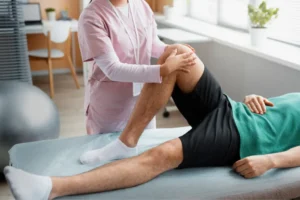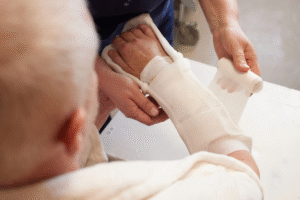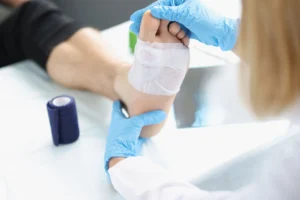Understanding Non-Healing Wounds
Non-healing wounds are injuries that do not follow the normal healing process within the expected timeframe, often lasting weeks or months without significant improvement. These wounds can arise from various conditions such as diabetes, vascular insufficiency, infections, or pressure ulcers, and they frequently require specialized care. Unlike minor cuts or surgical wounds that close quickly with standard medical attention, chronic wounds remain open, painful, and susceptible to further complications. Patients with orthopedic conditions may face an even greater risk because musculoskeletal factors like bone alignment, joint pressure, and mobility issues interfere with healing. Left untreated, non-healing wounds can lead to severe infections, reduced mobility, and even amputation. This makes it essential for patients and caregivers to understand that these wounds are more than just slow-to-heal injuries — they are complex medical conditions requiring advanced treatment strategies. Addressing these issues early with orthopedic expertise can help preserve function and overall quality of life.
How Orthopedic Specialists Address Non-Healing Wounds
Orthopedic specialists play a critical role in managing wounds that fail to heal because their training focuses on the interaction between bone, muscle, and tissue. While wound care centers may manage surface treatments, orthopedic doctors evaluate the deeper structural causes that prevent closure. For example, improper bone alignment, pressure from joints, or underlying fractures may cause wounds to remain open despite standard care. Orthopedic treatment for non-healing wounds involves a combination of surgical and non-surgical strategies aimed at restoring proper function and reducing strain on the affected area. These specialists often collaborate with endocrinologists, vascular surgeons, and infectious disease experts to provide comprehensive care. By integrating orthopedic insight into wound management, patients benefit from treatment plans that target both the surface wound and the underlying musculoskeletal challenges. This holistic approach ensures that wounds are not just temporarily managed but are supported to heal completely.
Common Conditions That Lead to Non-Healing Wounds
Several medical conditions contribute to wounds that resist healing, and many of these overlap with orthopedic concerns. Diabetic foot ulcers are among the most common, where high blood sugar impairs circulation and sensation, leading to injuries that go unnoticed until they worsen. Orthopedic involvement becomes necessary when the ulcer affects bones or joints, raising the risk of osteomyelitis. Pressure injuries also occur in patients with limited mobility due to fractures, spinal conditions, or post-surgical immobility, and they often progress into severe wounds without proactive care. Surgical wounds from orthopedic procedures such as joint replacements or fracture repairs can also fail to heal, especially when compounded by infection or systemic conditions. Chronic venous insufficiency and arterial disease may reduce blood flow, slowing down tissue repair in the lower extremities. All these conditions highlight the need for orthopedic treatment for non-healing wounds because bones and joints often play a role in why these injuries persist. By treating both the surface and the musculoskeletal foundation, orthopedic care helps address the full scope of the problem.
Orthopedic Diagnostic Approaches for Non-Healing Wounds
Accurate diagnosis is a cornerstone of effective orthopedic treatment for non-healing wounds. Specialists begin with a physical examination to assess the wound’s condition, size, and surrounding tissue health. Imaging studies like X-rays and MRIs provide insight into whether the wound is connected to bone damage, fractures, or infections such as osteomyelitis. CT scans may also be used for more detailed views of complex cases. Laboratory testing helps identify infections, inflammatory markers, and underlying systemic conditions that may interfere with healing. Beyond imaging and lab work, orthopedic doctors often conduct biomechanical assessments to understand gait, pressure distribution, and stress points on the affected limb. These diagnostic tools allow specialists to tailor treatment strategies, ensuring that each patient receives precise care based on the actual root causes. By identifying musculoskeletal factors and systemic barriers, orthopedic specialists provide a comprehensive evaluation that guides advanced wound management.
Orthopedic Treatment Options for Non-Healing Wounds
Orthopedic treatment for non-healing wounds includes a wide range of interventions designed to address both surface injuries and deeper structural issues. Surgical debridement is one of the most common procedures, where dead or infected tissue is removed to encourage fresh healing. In cases where wounds are linked to unstable fractures or misaligned bones, orthopedic stabilization techniques such as plates, screws, or rods may be used to reduce mechanical stress. For more advanced cases, wound closure techniques like skin grafts or flap surgery are applied, often requiring collaboration between orthopedic and plastic surgeons. Non-surgical options include orthotic devices such as braces and custom footwear, which redistribute pressure and allow the wound to heal without constant strain. Regenerative therapies like platelet-rich plasma (PRP) or stem cell therapy are also emerging as innovative solutions in orthopedic wound care. By combining these approaches, orthopedic specialists create individualized treatment plans that maximize the chances of healing while restoring mobility and comfort.
Importance of Infection Control in Orthopedic Wound Treatment
Infection control is one of the most critical aspects of managing non-healing wounds, particularly when the infection extends to the bone, leading to chronic osteomyelitis. Orthopedic specialists use both surgical and medical methods to address these risks. Surgical debridement removes infected tissue, while systemic or localized antibiotics help eliminate bacteria. In some cases, antibiotic beads or spacers are placed directly into the wound site to deliver high concentrations of medication. Controlling infection is vital because untreated infections can spread, causing further complications and increasing the risk of amputation. Preventive strategies are equally important and may include proper wound dressing, hygiene education, and close monitoring for signs of reinfection. Orthopedic expertise ensures that infections are not only treated but prevented from recurring through structural correction and careful follow-up. For patients, this means better long-term outcomes and reduced fear of chronic complications.
Rehabilitation and Supportive Orthopedic Care
Recovery from non-healing wounds does not end with surgical or medical intervention; rehabilitation is a vital part of the process. Physiotherapy helps restore circulation, mobility, and strength, all of which are essential for wound recovery. Orthopedic specialists often recommend custom footwear or braces to offload pressure from the wound site, allowing healing without additional strain. Pain management strategies, including medications and therapeutic exercises, provide patients with greater comfort and support throughout recovery. Nutritional counseling is also emphasized because adequate protein, vitamins, and minerals play a direct role in tissue repair. Lifestyle changes, such as smoking cessation and blood sugar control, further enhance the healing process. Supportive care ensures that patients not only recover from their current wound but also reduce the likelihood of recurrence. Orthopedic-led rehabilitation integrates physical, structural, and lifestyle strategies to create a strong foundation for lasting health.
When to Seek Orthopedic Help for Non-Healing Wounds
Recognizing the right time to seek orthopedic help can make the difference between recovery and serious complications. Patients should consult an orthopedic specialist if a wound does not show signs of improvement within several weeks, or if it becomes increasingly painful, swollen, or infected. Diabetic patients in particular should be vigilant, as small injuries can rapidly progress into severe ulcers requiring advanced care. Warning signs include persistent redness, discharge, exposure of deeper tissues, or difficulty bearing weight on the affected limb. Early orthopedic intervention helps reduce the risk of amputation and ensures that musculoskeletal issues contributing to the wound are properly addressed. By involving orthopedic care sooner rather than later, patients have a greater chance of preserving mobility, preventing systemic infection, and maintaining quality of life. Caregivers and families should also be aware of these warning signs to encourage timely treatment.
FAQ Section
Q1: What makes orthopedic treatment different for non-healing wounds?
Orthopedic treatment targets both the wound itself and the underlying musculoskeletal issues such as bone alignment, joint stress, and mobility limitations. This dual approach helps create conditions for faster and more effective healing.
Q2: Can orthopedic specialists treat diabetic wounds effectively?
Yes. Orthopedic specialists are often part of multidisciplinary teams that treat diabetic wounds. They address bone involvement, stabilize affected areas, and recommend orthotic devices to relieve pressure, all of which are essential in managing diabetic ulcers.
Q3: How do orthotic devices help with non-healing wounds?
Orthotic devices redistribute weight and reduce pressure on vulnerable areas, allowing wounds to heal without constant strain. They are particularly beneficial for patients with foot or leg wounds that are affected by gait or posture issues.
Q4: What are the risks of delaying orthopedic care for chronic wounds?
Delaying care can lead to worsening infections, chronic pain, reduced mobility, and in severe cases, the need for amputation. Early orthopedic intervention reduces these risks and promotes better long-term outcomes.
Q5: Are surgical treatments always required for non-healing wounds?
Not always. While some cases require surgical debridement or wound closure, many patients benefit from non-surgical methods such as orthotics, physiotherapy, and regenerative medicine. Treatment is customized based on the wound’s severity and underlying causes.
Understanding Non-Healing Wounds
Non-healing wounds are injuries that do not follow the normal healing process within the expected timeframe, often lasting weeks or months without significant improvement. These wounds can arise from various conditions such as diabetes, vascular insufficiency, infections, or pressure ulcers, and they frequently require specialized care. Unlike minor cuts or surgical wounds that close quickly with standard medical attention, chronic wounds remain open, painful, and susceptible to further complications. Patients with orthopedic conditions may face an even greater risk because musculoskeletal factors like bone alignment, joint pressure, and mobility issues interfere with healing. Left untreated, non-healing wounds can lead to severe infections, reduced mobility, and even amputation. This makes it essential for patients and caregivers to understand that these wounds are more than just slow-to-heal injuries — they are complex medical conditions requiring advanced treatment strategies. Addressing these issues early with orthopedic expertise can help preserve function and overall quality of life.
How Orthopedic Specialists Address Non-Healing Wounds
Orthopedic specialists play a critical role in managing wounds that fail to heal because their training focuses on the interaction between bone, muscle, and tissue. While wound care centers may manage surface treatments, orthopedic doctors evaluate the deeper structural causes that prevent closure. For example, improper bone alignment, pressure from joints, or underlying fractures may cause wounds to remain open despite standard care. Orthopedic treatment for non-healing wounds involves a combination of surgical and non-surgical strategies aimed at restoring proper function and reducing strain on the affected area. These specialists often collaborate with endocrinologists, vascular surgeons, and infectious disease experts to provide comprehensive care. By integrating orthopedic insight into wound management, patients benefit from treatment plans that target both the surface wound and the underlying musculoskeletal challenges. This holistic approach ensures that wounds are not just temporarily managed but are supported to heal completely.
Common Conditions That Lead to Non-Healing Wounds
Several medical conditions contribute to wounds that resist healing, and many of these overlap with orthopedic concerns. Diabetic foot ulcers are among the most common, where high blood sugar impairs circulation and sensation, leading to injuries that go unnoticed until they worsen. Orthopedic involvement becomes necessary when the ulcer affects bones or joints, raising the risk of osteomyelitis. Pressure injuries also occur in patients with limited mobility due to fractures, spinal conditions, or post-surgical immobility, and they often progress into severe wounds without proactive care. Surgical wounds from orthopedic procedures such as joint replacements or fracture repairs can also fail to heal, especially when compounded by infection or systemic conditions. Chronic venous insufficiency and arterial disease may reduce blood flow, slowing down tissue repair in the lower extremities. All these conditions highlight the need for orthopedic treatment for non-healing wounds because bones and joints often play a role in why these injuries persist. By treating both the surface and the musculoskeletal foundation, orthopedic care helps address the full scope of the problem.
Orthopedic Diagnostic Approaches for Non-Healing Wounds
Accurate diagnosis is a cornerstone of effective orthopedic treatment for non-healing wounds. Specialists begin with a physical examination to assess the wound’s condition, size, and surrounding tissue health. Imaging studies like X-rays and MRIs provide insight into whether the wound is connected to bone damage, fractures, or infections such as osteomyelitis. CT scans may also be used for more detailed views of complex cases. Laboratory testing helps identify infections, inflammatory markers, and underlying systemic conditions that may interfere with healing. Beyond imaging and lab work, orthopedic doctors often conduct biomechanical assessments to understand gait, pressure distribution, and stress points on the affected limb. These diagnostic tools allow specialists to tailor treatment strategies, ensuring that each patient receives precise care based on the actual root causes. By identifying musculoskeletal factors and systemic barriers, orthopedic specialists provide a comprehensive evaluation that guides advanced wound management.
Orthopedic Treatment Options for Non-Healing Wounds
Orthopedic treatment for non-healing wounds includes a wide range of interventions designed to address both surface injuries and deeper structural issues. Surgical debridement is one of the most common procedures, where dead or infected tissue is removed to encourage fresh healing. In cases where wounds are linked to unstable fractures or misaligned bones, orthopedic stabilization techniques such as plates, screws, or rods may be used to reduce mechanical stress. For more advanced cases, wound closure techniques like skin grafts or flap surgery are applied, often requiring collaboration between orthopedic and plastic surgeons. Non-surgical options include orthotic devices such as braces and custom footwear, which redistribute pressure and allow the wound to heal without constant strain. Regenerative therapies like platelet-rich plasma (PRP) or stem cell therapy are also emerging as innovative solutions in orthopedic wound care. By combining these approaches, orthopedic specialists create individualized treatment plans that maximize the chances of healing while restoring mobility and comfort.
Importance of Infection Control in Orthopedic Wound Treatment
Infection control is one of the most critical aspects of managing non-healing wounds, particularly when the infection extends to the bone, leading to chronic osteomyelitis. Orthopedic specialists use both surgical and medical methods to address these risks. Surgical debridement removes infected tissue, while systemic or localized antibiotics help eliminate bacteria. In some cases, antibiotic beads or spacers are placed directly into the wound site to deliver high concentrations of medication. Controlling infection is vital because untreated infections can spread, causing further complications and increasing the risk of amputation. Preventive strategies are equally important and may include proper wound dressing, hygiene education, and close monitoring for signs of reinfection. Orthopedic expertise ensures that infections are not only treated but prevented from recurring through structural correction and careful follow-up. For patients, this means better long-term outcomes and reduced fear of chronic complications.
Rehabilitation and Supportive Orthopedic Care
Recovery from non-healing wounds does not end with surgical or medical intervention; rehabilitation is a vital part of the process. Physiotherapy helps restore circulation, mobility, and strength, all of which are essential for wound recovery. Orthopedic specialists often recommend custom footwear or braces to offload pressure from the wound site, allowing healing without additional strain. Pain management strategies, including medications and therapeutic exercises, provide patients with greater comfort and support throughout recovery. Nutritional counseling is also emphasized because adequate protein, vitamins, and minerals play a direct role in tissue repair. Lifestyle changes, such as smoking cessation and blood sugar control, further enhance the healing process. Supportive care ensures that patients not only recover from their current wound but also reduce the likelihood of recurrence. Orthopedic-led rehabilitation integrates physical, structural, and lifestyle strategies to create a strong foundation for lasting health.
When to Seek Orthopedic Help for Non-Healing Wounds
Recognizing the right time to seek orthopedic help can make the difference between recovery and serious complications. Patients should consult an orthopedic specialist if a wound does not show signs of improvement within several weeks, or if it becomes increasingly painful, swollen, or infected. Diabetic patients in particular should be vigilant, as small injuries can rapidly progress into severe ulcers requiring advanced care. Warning signs include persistent redness, discharge, exposure of deeper tissues, or difficulty bearing weight on the affected limb. Early orthopedic intervention helps reduce the risk of amputation and ensures that musculoskeletal issues contributing to the wound are properly addressed. By involving orthopedic care sooner rather than later, patients have a greater chance of preserving mobility, preventing systemic infection, and maintaining quality of life. Caregivers and families should also be aware of these warning signs to encourage timely treatment.
FAQ Section
Q1: What makes orthopedic treatment different for non-healing wounds?
Orthopedic treatment targets both the wound itself and the underlying musculoskeletal issues such as bone alignment, joint stress, and mobility limitations. This dual approach helps create conditions for faster and more effective healing.
Q2: Can orthopedic specialists treat diabetic wounds effectively?
Yes. Orthopedic specialists are often part of multidisciplinary teams that treat diabetic wounds. They address bone involvement, stabilize affected areas, and recommend orthotic devices to relieve pressure, all of which are essential in managing diabetic ulcers.
Q3: How do orthotic devices help with non-healing wounds?
Orthotic devices redistribute weight and reduce pressure on vulnerable areas, allowing wounds to heal without constant strain. They are particularly beneficial for patients with foot or leg wounds that are affected by gait or posture issues.
Q4: What are the risks of delaying orthopedic care for chronic wounds?
Delaying care can lead to worsening infections, chronic pain, reduced mobility, and in severe cases, the need for amputation. Early orthopedic intervention reduces these risks and promotes better long-term outcomes.
Q5: Are surgical treatments always required for non-healing wounds?
Not always. While some cases require surgical debridement or wound closure, many patients benefit from non-surgical methods such as orthotics, physiotherapy, and regenerative medicine. Treatment is customized based on the wound’s severity and underlying causes.











